
Stardate: 2017 and beyond…
These be the reports from Ade Press’s cybernautical explorations and experiments in stand-out VR… A continuing mission, to seek out and explore the more noteworthy VR worlds; to go boldly where many other, less thoughtful writers have ‘been’ before…
- Focus: Affordable/mobile VR
- Equipment: Samsung GEAR VR with controller (2018)
- Content: Oculus Store and Youtube.
Are there experiences out there you’d personally recommend? Please comment!
……
UPDATE 2022…..
- Focus: Major / Green / Nature-themed VR experiences
- Equipment: Oculus QUEST 2
- Content: Oculus Store
More about why VR can be great!
Virtual Reality (VR) has emerged as a groundbreaking medium that holds immense potential for various purposes, including experience, exploration, and learning. With its ability to create immersive, interactive, and lifelike virtual environments, VR has transformed the way we engage with digital content and has opened up new possibilities for human interaction and understanding. We will briefly explore why VR still has the potential to be a great medium, recognising too some important limitations.
1. Immersive Experiences
VR offers an unprecedented level of immersion, allowing users to step into virtual worlds and experience them firsthand. Whether it’s exploring ancient civilizations, diving into the depths of the ocean, or traveling to space, VR enables us to go beyond the boundaries of our physical reality and engage with experiences that were once unimaginable. By placing users at the center of these virtual environments, VR creates a profound sense of presence, transporting them to new places and enabling emotional connections that traditional media cannot replicate.
2. Interactive and Engaging
In addition to immersion, VR provides a highly interactive and engaging experience. With the use of motion controllers or even hand gestures, users can interact with objects, manipulate their surroundings, and engage in realistic simulations. This interactivity fosters a sense of agency and empowers users to actively participate and shape their virtual experiences. Whether it’s solving puzzles, conducting virtual experiments, or collaborating with others in shared virtual spaces, VR offers a level of engagement that enhances learning and exploration.
3. Empathy and Understanding
VR etc. has the unique ability to foster empathy and understanding by allowing users to see and experience the world from different perspectives. By immersing users in virtual scenarios, VR can simulate real-life situations, such as empathizing with the challenges faced by people with disabilities, understanding the experiences of marginalized communities, or even witnessing historical events. This empathetic connection promotes understanding, compassion, and can help bridge gaps in empathy and cultural understanding.
4. Simulations and Training
VR etc. has proven to be a valuable tool in various industries for training and simulations. From medical procedures to flight simulations, VR offers a safe and controlled environment for learners to practice and develop new skills. By providing realistic and repeatable scenarios, VR training can help improve performance, reduce risks, and enhance learning outcomes. The ability to recreate complex and potentially dangerous situations in a virtual space enables learners to gain practical experience.
5. Social Interaction
This last item continues to be the greatest hurdle for VR due to the private-versus-social nature of VR and the current status of today’s headsets. It was perhaps a reason for Meta’s difficulties in predicting whether or not its Horizon Worlds Metaverse investment would pay off post-pandemic. [No, it was just too early, despite some of the technology to make aspects possible present in Quest 2 headsets.]
However, sharing virtual spaces may become more of an option for some companies to reduce travel costs. Also, beginning from within the family circle, increased familiarity with shared games and experiences along with advances in life-like avatars, internet speeds and headset design, should lead more people into certain social spaces, including museums, galleries, cinemas, metaverse spaces and workspaces. Users wearing headsets with mixed reality capability where the virtual and real become blended may also be more attractive.
Ultimately something to consider is that users wearing headsets like to feel they are involved either in story, experience or something educational – or socially fulfilling.
Social networks on mobile phones have not really met this need, despite huge usage, popularity and self-promotion. Feeding an online social experience back into reality (and thereby complementing this existing reality – such as local life and a sense of real belonging – is a much harder ask, for any technology.
However, VR may still be a tool that starts to make this more possible in the hands of trusting users united by a shared purpose or community that can seamlessly skip between the real and the virtual.

